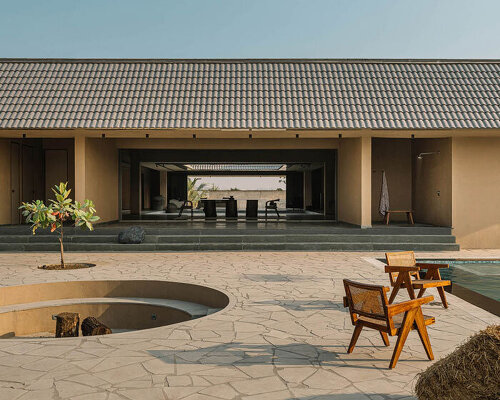a central sunken open space anchors Courtyard House
Located on the northeastern edge of a large site near Surat, India, the Courtyard House by D’WELL is a 920-square-meter farmhouse designed around a central sunken courtyard. The design adopts a concentric plan, using the courtyard, measuring 9 by 9 meters, as both a spatial and climatic organizing element.
Access to the residence is through a foyer that leads into the primary living area on the southeast side. This space opens directly onto the courtyard, establishing a continuous visual and spatial connection between interior and exterior zones. The northeast and northwest sides of the courtyard are framed by the family block, which contains a secondary living space, dining area, kitchen, and powder room. These areas extend outward to a party lawn and a family seating area, emphasizing the integration between architecture and open landscape. The private wing is located along the southwest edge and includes three bedrooms, each with an en suite bathroom and dressing area. These rooms overlook an adjacent organic farm plot, ensuring cross-ventilation and daylight access. Throughout the residence, semi-open transitional spaces support passive cooling strategies, which are particularly relevant to the humid local climate.
all images by Ishita Sitwala
D’WELL employs a restrained earthen palette and form
The architectural language D’WELL’s design team followed draws from traditional tropical housing typologies, specifically early Chettinad-style dwellings. Axial views from the central courtyard extend toward the surrounding landscape, while a sloped roof over the courtyard frames the sky above, creating a controlled visual opening. The roof, clad in custom cement tiles, unifies the structure and contributes to thermal regulation.
Material selections are made in response to both context and performance. Hand-applied sand-textured plaster on walls matches the surrounding soil tone, and rough-cut Kota stone mosaic flooring spans both interior and exterior surfaces, reinforcing continuity. Wood is used selectively in furniture and door detailing to introduce material contrast. Furniture and decorative elements, including vintage artifacts and earthen vessels, are positioned within circulation and gathering spaces, aligning with the residence’s spatial rhythm. The project employs a restrained palette and form, using traditional materials within a contemporary framework. The central courtyard operates as the core spatial and environmental element, supporting the house’s broader approach to climatic responsiveness, spatial openness, and integration with the landscape.
a central sunken courtyard anchors the spatial and climatic layout
the sloped roof frames axial views and open sky above the courtyard
spatial organization extends outward to a party lawn and seating zones
courtyard layout draws from early Chettinad-style tropical homes
Kota stone mosaic floors unify indoor and outdoor zones
custom cement tiles clad the sloped roof for thermal regulation
earthen pots and vintage objects enhance spatial character
project info:
name: The Courtyard House
architect: D’WELL | @d_welldesign
lead designers: Ar. Jhanvi Shah, Ar. Rakshit Shah
design team: Jhanvi Mehta, Rakshit Shah, Sefali Balotia
location: Surat, Gujarat, India
photographer: Ishita Sitwala | @ishifishy
designboom has received this project from our DIY submissions feature, where we welcome our readers to submit their own work for publication. see more project submissions from our readers here.
edited by: christina vergopoulou | designboom
The post sculpted shell of stone and plaster encircles courtyard house by d’well in india appeared first on designboom | architecture & design magazine.

